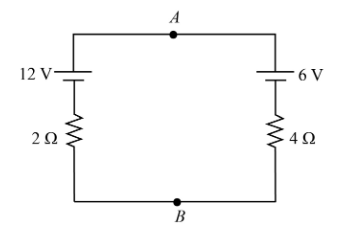Answer
426.6k+ views
Hint: In the solution we will use the Kirchhoff’s second law in both the loops. Also Ohm’s law is employed to find the current passing through the circuit. When a circuit is considered we have to include all the parameters that are included in the circuit.
Complete step by step answer:
Given is the circuit with two cells each of $12\;{\rm{V}}$ and $6\;{\rm{V}}$ with corresponding resistances $2\;\Omega $ and $4\;\Omega $ respectively.
Let us suppose that the current passing through the circuit is $i$.
From Ohm's law, we know, $V = iR$, where $V$ is the voltage, $i$ is the current and $R$ is the resistance. Therefore applying this, to the two resistances, we have,
The voltage across the resistance $2\;\Omega $ is $V = 2i$ and the voltage across the resistance $4\;\Omega $ is $V = 4i$
As we know that, according to Kirchhoff’s second law, in any closed loop network, the total voltage around the loop is equal to the sum of all the voltage drops within the same loop. This means that the total voltage within the loop is equal to zero. Starting at any point in the loop continues in the same direction noting the direction of all the voltage drops, either positive or negative, and returning back to the same starting point. It is important to maintain the same direction either clockwise or anti-clockwise or the final voltage sum will not be equal to zero. We can use Kirchhoff’s voltage law when analysing series circuits.
Hence from the given loop we have,
$
\Rightarrow 12\;{\rm{V}} - 6\;{\rm{V}} - 4i - 2i = 0\\
\Rightarrow 6\;{\rm{V}} = 6i\\
\Rightarrow i = 1\;{\rm{A}}
$
Thus the voltage across the resistance $4\;\Omega $ is $V = 4\;\Omega \times 1\;{\rm{A}} = 4\;{\rm{V}}$.
Now applying the Kirchhoff’s law to the right side of the loop starting from A to B through $4\;\Omega $, we have,
$
{V_A} - 6\;{\rm{V}} - 4\;{\rm{V}} - {V_B} = 0\\
\therefore{V_A} - {V_B} = 10\;{\rm{V}}
$
Therefore the Potential difference across AB, i.e.,${V_A} - {V_B}$ is $10\;{\rm{V}}$.
Hence,option (1) is the correct answer.
Note: Make sure to calculate the voltage through the resistance. All the voltages in the loops are to be considered while applying Kirchhoff's law. When a loop is considering, make sure that the loop is counted in the same way, either clockwise or anticlockwise in all the cases.
Complete step by step answer:
Given is the circuit with two cells each of $12\;{\rm{V}}$ and $6\;{\rm{V}}$ with corresponding resistances $2\;\Omega $ and $4\;\Omega $ respectively.
Let us suppose that the current passing through the circuit is $i$.
From Ohm's law, we know, $V = iR$, where $V$ is the voltage, $i$ is the current and $R$ is the resistance. Therefore applying this, to the two resistances, we have,
The voltage across the resistance $2\;\Omega $ is $V = 2i$ and the voltage across the resistance $4\;\Omega $ is $V = 4i$
As we know that, according to Kirchhoff’s second law, in any closed loop network, the total voltage around the loop is equal to the sum of all the voltage drops within the same loop. This means that the total voltage within the loop is equal to zero. Starting at any point in the loop continues in the same direction noting the direction of all the voltage drops, either positive or negative, and returning back to the same starting point. It is important to maintain the same direction either clockwise or anti-clockwise or the final voltage sum will not be equal to zero. We can use Kirchhoff’s voltage law when analysing series circuits.
Hence from the given loop we have,
$
\Rightarrow 12\;{\rm{V}} - 6\;{\rm{V}} - 4i - 2i = 0\\
\Rightarrow 6\;{\rm{V}} = 6i\\
\Rightarrow i = 1\;{\rm{A}}
$
Thus the voltage across the resistance $4\;\Omega $ is $V = 4\;\Omega \times 1\;{\rm{A}} = 4\;{\rm{V}}$.
Now applying the Kirchhoff’s law to the right side of the loop starting from A to B through $4\;\Omega $, we have,
$
{V_A} - 6\;{\rm{V}} - 4\;{\rm{V}} - {V_B} = 0\\
\therefore{V_A} - {V_B} = 10\;{\rm{V}}
$
Therefore the Potential difference across AB, i.e.,${V_A} - {V_B}$ is $10\;{\rm{V}}$.
Hence,option (1) is the correct answer.
Note: Make sure to calculate the voltage through the resistance. All the voltages in the loops are to be considered while applying Kirchhoff's law. When a loop is considering, make sure that the loop is counted in the same way, either clockwise or anticlockwise in all the cases.
Recently Updated Pages
Mark and label the given geoinformation on the outline class 11 social science CBSE

When people say No pun intended what does that mea class 8 english CBSE

Name the states which share their boundary with Indias class 9 social science CBSE

Give an account of the Northern Plains of India class 9 social science CBSE

Change the following sentences into negative and interrogative class 10 english CBSE

Advantages and disadvantages of science

Trending doubts
Difference between Prokaryotic cell and Eukaryotic class 11 biology CBSE

Which are the Top 10 Largest Countries of the World?

Fill the blanks with the suitable prepositions 1 The class 9 english CBSE

Differentiate between homogeneous and heterogeneous class 12 chemistry CBSE

Difference Between Plant Cell and Animal Cell

10 examples of evaporation in daily life with explanations

Give 10 examples for herbs , shrubs , climbers , creepers

Write a letter to the principal requesting him to grant class 10 english CBSE

How do you graph the function fx 4x class 9 maths CBSE




